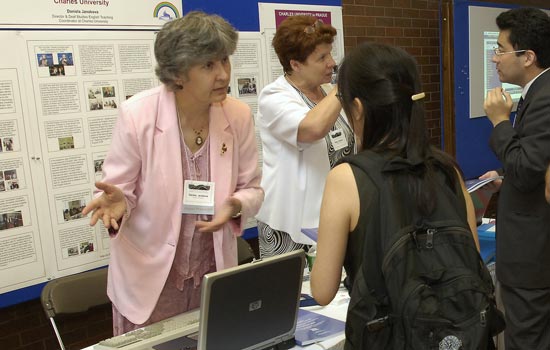Computers, Conferencing and Concepts Shown at Tech Symposium at RIT/NTID
Improving education of deaf students is the goal
Submitted photo
Dozens of exhibits and presentations are again planned for this year’s Tech Symposium on Technology and Deaf Education at RIT/NTID—just like the symposium held in 2005 (above).
Hundreds of educators from around the world are coming to Rochester June 23-25 to learn about the latest educational and access technologies available to aid the teaching of deaf students.
This is the fifth International Symposium on Technology and Deaf Education hosted at Rochester Institute of Technology’s National Technical Institute for the Deaf.
About 250 people are expected for the three-day symposium beginning Monday. They’ll be coming from across the United States and more than a dozen foreign countries.
Attendees will explore ways they may better teach their deaf students as well as learn about new technology that can be used to provide access services to support their students in the classroom.
The event is a rare opportunity for educators to network and discuss technological issues and advancements in their classrooms, including speech-to-text services, Web conferencing, wireless emergency communications and distance learning.
“Bringing these people together doesn’t occur frequently,” says symposium chairman William Clymer, associate director of Postsecondary Education Network-International, which is sponsoring the event along with RIT/NTID and the Nippon Foundation of Japan.
This unique venue also enables people from other countries to share their needs and success stories in education of the deaf. Speakers attending are from Greece, India, Japan, China, the Czech Republic, Korea and Russia.
For example, technology in Japan and Korea enables videoconferencing via cell phones. The use of Internet Protocol for videoconferencing in the United States has dramatically improved in the last few years. Now, live meetings may be held on the Internet by people in different hemispheres. This technology can be extremely helpful to aid students in classrooms where interpreters or captionists may not be available.
“We need to find ways to reach out to these young deaf and hard-of-hearing people and provide them with information so that they can learn and grow and become successful in their careers,” says NTID President Alan Hurwitz.













